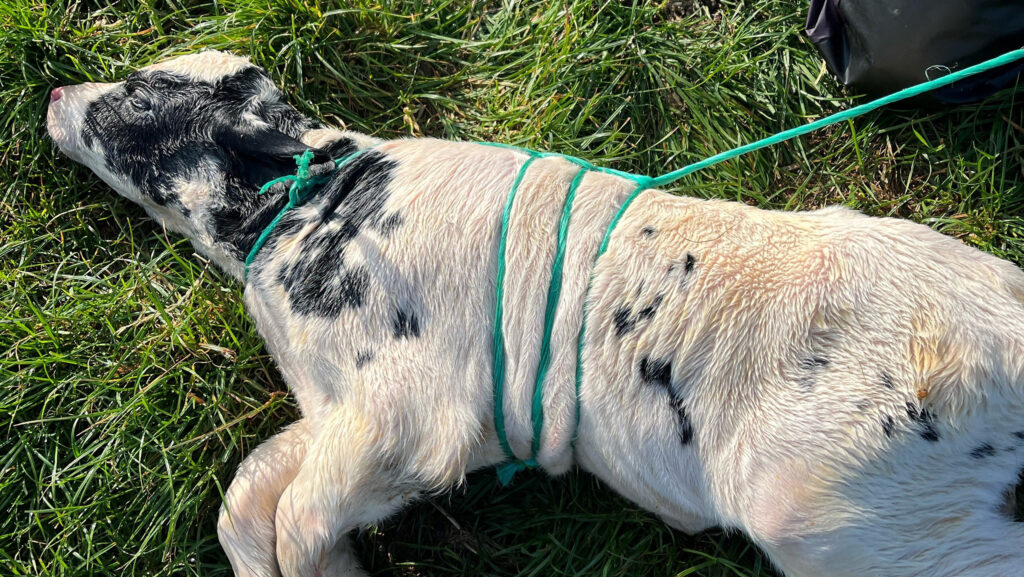How a ‘big squeeze’ could help dummy calves to suck
 Madigan squeeze on calf © Sam Chinn/Causeway Farm
Madigan squeeze on calf © Sam Chinn/Causeway Farm Neonatal maladjustment syndrome in calves – also known as “dummy calf” syndrome – can be a challenge for dairy farmers to manage, often requiring extra labour to tube-feed youngstock.
Typically, affected calves are slow to stand and reluctant to suck but otherwise appear healthy.
Failure to suck results in poor growth rates, and death in the most severe situations.
However, a novel technique of applying tension to the thorax of an animal – initially developed for the equine sector – could be the cure, according to research from Portugal.
It was first developed by US professor Dr John Madigan – leading it to be coined the Madigan squeeze.
See also: Tips on getting reluctant calves to suck a bottle
The technique has three steps:
- Three concentric loops made from soft rope are tied around the chest/thorax
- The animal is laid down and gentle tension – a squeeze – is applied to the rope and held in place for 20 minutes, putting the animal into a sleep-like state
- The tension is released, and the animal is able to stand and suck as normal.
Following success in foals, Prof George Stilwell of the University of Lisbon looked at whether the same effect would be seen in calves in a 2019 study.
He presented his findings at the 14th Expert Forum on Farm Animal Well-Being, held this summer in Porto.
He trialled the technique on two calves born by caesarean section, one at six hours after delivery and the other after 20 hours.
In both cases, when the tension was released, the calves stood, walked towards the dam’s udder and began to suck.
Science behind the squeeze
According to George, during a normal journey through labour, squeezing the calf through the birth canal triggers a hormonal response – the norepinephrine release – which enables the calf to transition from the intrauterine state to being active and alert once born.
Where this does not happen – for example, due to a caesarean section or a particularly quick birth – this hormonal response does not always occur, leading to the presentation of a “dummy” calf.
George believes that recreating this squeeze and release outside the womb enables this hormonal response to occur.
UK success
In the UK, a few vets have been practising this technique, including Paul Doran of Friars Moor Livestock Health.
He reports seeing instant success in cases where there are no other plausible explanations for the calf’s condition.
“My experience of doing it is quite anecdotal, but I’ve performed it on dummy calves that didn’t have much of a suck reflex but otherwise were healthy calves.
“Often, this has been calves who have slipped out too quickly, meaning the normal [hormonal] stimulus hasn’t occurred.”
Paul says he has seen very good results, even when carried out up to a week post-birth.
This is despite literature suggesting it is best performed within 48 hours – with calves showing immediate signs of recovery.
He adds that he has seen no evidence that this impacts longer-term performance either.
He says the technique can be performed by a vet or a farmer, providing they know the correct technique and there are no contraindications from birth, such as broken ribs.
“It’s not an act of surgery, so I think it’s fine for a farmer to do it as long as they have learned the technique correctly and aren’t likely to suffocate the calf.
“One of my colleagues has actually talked a farmer through it over the phone before.”
